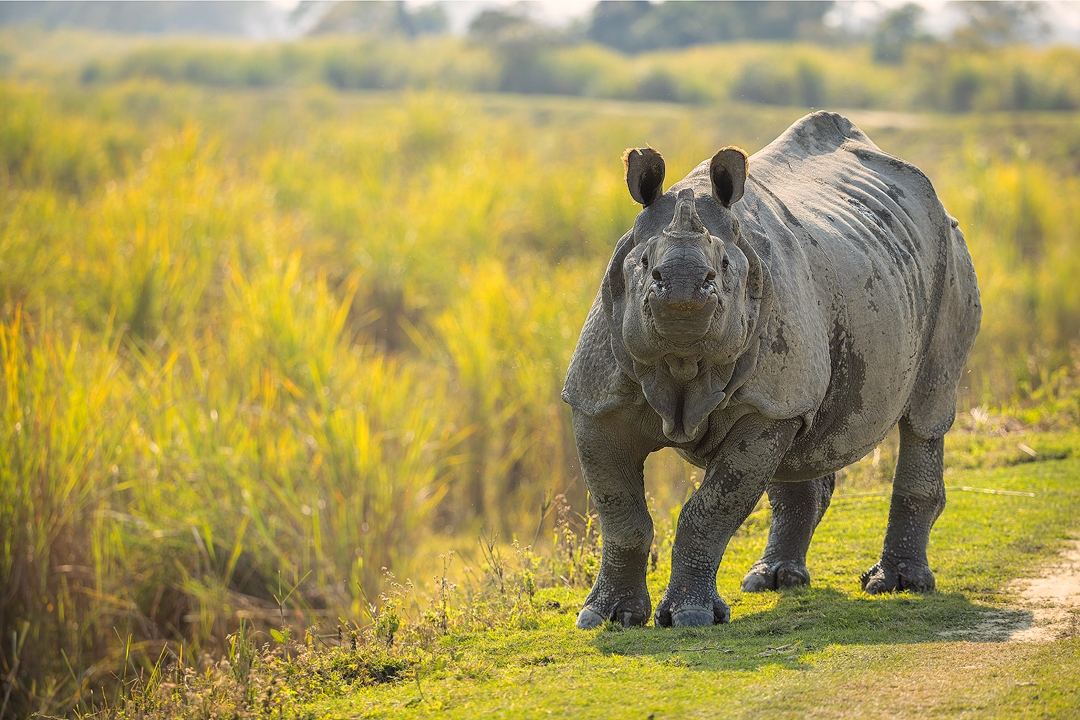Grumpy one-horned rhino
Grumpy one-horned rhino. Indian Rhino (Rhinoceros unicornis) raises its head threateningly in grassland habitat. Kaziranga National Park, Assam, India.
Thanks to their enormous size and thick armour-like hide, rhinos have no natural predators. Despite this they are notoriously grumpy and easily spooked. When they feel threatened they tend to charge directly at whatever has scared them!
Grumpy one-horned rhino – About the Great Indian Rhino:
The Greater one-horned rhinoceros (Rhinoceros unicornis) also known as the Indian rhinoceros , and the great Indian rhinoceros, is a species of rhino native to the Indian subcontinent.
The greater one-horned rhino is the largest of the rhino species, a title shared with the African White Rhinoceros. Indian rhinoceros’ were once widespread across much of the Indian sub-continent, but as the human population increased, the rhino population grew close to extinction after excessive hunting and conflict with local farmers. By the start of the 20th century, it was estimated that just 200 greater one-horned rhinos remained in the wild.
The incredible recovery of the greater one-horned rhino from the brink of extinction is one of the greatest conservation success stories in the world. Through strict protection from poaching and land management by wildlife authorities, the great Indian rhinoceros was brought back from the almost certain extinction. Today the population is estimated at 3,500 rhinos, found in northeastern India and the grasslands of Nepal, particularly in Kaziranga National Park and Chitwan.
These giants can be identified by their single horns, which can grow up to about 25 inches long. Their thick grey hide with deep skin folds, makes them look as though they are wearing a suit of armour.
You can find out more about Greater one-horned rhinos here.
About Kaziranga National Park:
Kaziranga National Park was first established in 1905 with the help of Mary Curzon, the wife of Viceroy Lord Curzon of Kedleston. As Vicereine of India, Mary held the highest official title in the Indian Empire that a woman could hold. It is said that when Mary visited the area to see rhinos she was unable to find even one and so persuaded her husband to take urgent measures to protect the vulnerable species. After the legislation was passed the Kaziranga Reserve Forest was created with an area of 232 km2. In 1985 Kaziranga became a UNESCO world heritage and is now one of India’s most famous tourist destinations, located on the edge of the Himalayan biodiversity hotspot in the state of Assam.
Now covering 430² km, Kaziranga is dominated by dense tropical forests, marshland and vast expanses of giant elephant grass, so called because they can grow tall enough to hide even the largest animals. The Brahmaputra river that winds it way through the flood plains is the lifeblood of the area and gives the national park its amazing biodiversity.
Kaziranga is home to the world’s largest population of Greater one-horned rhinoceros. Over 2200 rhinos inhabit the elephant grass meadows and dense forests; approximately 2/3rd of total world population. The National Park is also home to many other endemic and endangered animals such as Hoolock Gibbons; India’s only ape, Indian Elephants, Sloth Bears, Wild water buffalo and swamp deer. An increase in the tiger population every year has also meant that Kaziranga was declared as a Tiger Reserve in the 2006 and it is now purported to have the highest density of tigers anywhere in the world.
Along with the wide range of mammal species the park is also recognised as an important area for birds. Rare birds such as the ferruginous duck, lesser white-fronted goose, Baer’s pochard, adjutant storks, black-necked storks, and Asian Openbill storks migrate here from the Central Asia during the winter.
